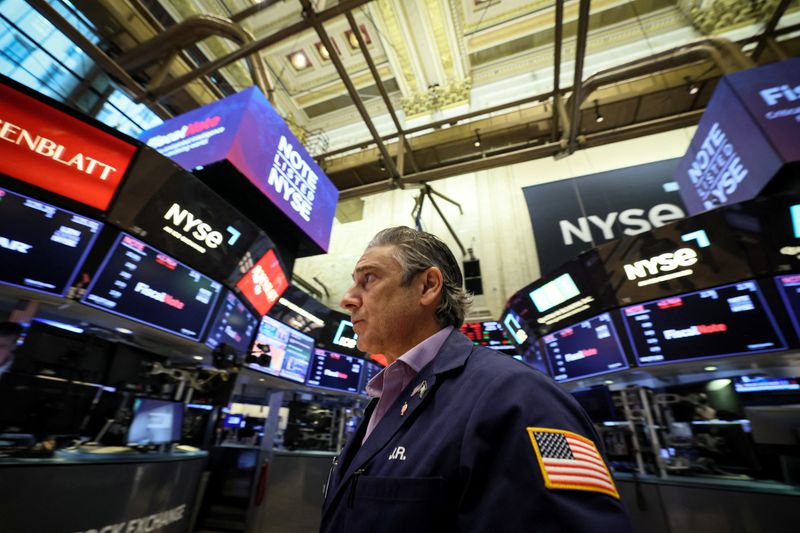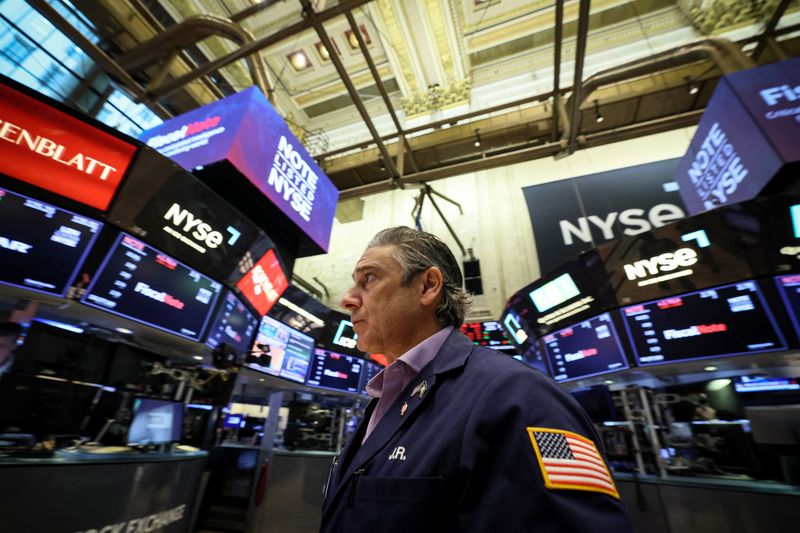Economy
Wall St Week Ahead: Last Fed hike tends to aid stocks, but some have doubts this time


© Reuters. Traders work on the floor of the New York Stock Exchange (NYSE) in New York City, U.S., August 15, 2023. REUTERS/Brendan McDermid/File Photo
By Lewis Krauskopf
NEW YORK (Reuters) – The end of the Federal Reserve’s rate hiking cycle has generally been a good time to own U.S. stocks, but an uncertain economic outlook and stretched valuations could dampen upside this time around.
After raising borrowing costs by 525 basis points since March 2022, the U.S. central bank is widely expected to keep rates unchanged at the conclusion of its meeting next week. Many investors believe that policymakers are unlikely to raise rates any further, bringing an end to the central bank’s most aggressive monetary policy tightening cycle in decades.
If they are right, stocks could be poised for more gains. After the Fed’s past six periods of credit tightening, the rose an average of 13% from the final rate hike to the first cut in the following cycle, an analysis by financial research firm CFRA showed.
Investors with a more bearish view, however, say it is only a matter of time before higher rates tighten economic conditions and bring a downturn. The S&P 500 is already up over 16% this year, aided in part by a U.S. economy that has stayed resilient in the face of higher interest rates.
“The market will probably cheer it a bit if it is the end of the Fed rate hike cycle,” said Schutte, chief investment officer at Northwestern (NASDAQ:) Mutual Wealth Management Company.
However, “I don’t think the economy is going to stay out of a recession and that is going to be what ultimately decides the direction of stocks,” said Schutte, whose firm favors fixed income over equities.
Though most investors believe a recession is unlikely in 2023, a slowdown next year remains a possibility for some market participants. One worrying recession signal has been the inverted Treasury yield curve, a market phenomenon that has preceded past downturns.
The Fed will give its policy statement on Wednesday, with odds at 97% that it will keep rates unchanged, according to the CME FedWatch Tool, which tracks bets on futures tied to the central bank’s policy rate. Traders see a roughly two-out-of three chance of the Fed leaving rates unchanged in November, CME’s data showed.
Odds for December show about a 60% chance rates of rates staying at current levels.
PEAK RATES?
Fed Chair Jerome Powell said last month that the central bank may need to raise rates further to cool inflation, promising to move carefully at upcoming meetings.
More of the kind of generally benign inflation data that has come over the last few months, however, could mean the Fed’s quarter-point increase in July was the last in a cycle that shook asset prices last year.
“If Wall Street comes to the conclusion that the Fed has ended its rate tightening program, that would at least offer support if not give (stocks) an additional catalyst to keep working higher,” said Sam Stovall, CFRA’s chief investment strategist.
Investors are also attempting to gauge when the Fed will begin easing monetary policy. CFRA found that the Fed has tended to cut rates an average of nine months after its last rate increase, with the S&P 500 gaining an average of 6.5% in the six months following the cut.
Investors are pricing in a small chance of a cut as early as the Fed’s January meeting, with expectations of a cut at about 35% for May, according to the CME data.
Some investors, however, see challenges for the stock market even if the Fed is done hiking.
Analysts at Oxford Economics forecast further downside for global earnings, noting that stocks “have typically delivered far weaker returns following the final Fed rate hike when it has coincided with an EPS downturn.”
Oxford and other investors are also wary of stock valuations, which have ballooned this year. The S&P 500 is trading at about 19 times forward 12-month earnings estimates versus 17 times at the start of the year and its long-term average of 15.6 times, according to LSEG Datastream.
Equity valuations are also threatened by the rise in bond yields, which has increased the attraction of fixed income as investment alternative to stocks. The yield on the 10-year Treasury is close to over 15-year highs. “If (the Fed) came out and said ‘we’re done,’ yeah I do think that is probably cause for some celebration,” said Jack Ablin, chief investment officer at Cresset Capital. “But I’m not sure how sustainable it would be given where stocks are valued relative to bonds already.”
Economy
Russian central bank says it needs months to make sure CPI falling before rate cuts -RBC


© Reuters. Russian Central Bank Governor Elvira Nabiullina attends a news conference in Moscow, Russia June 14, 2019. REUTERS/Shamil Zhumatov/File Photo
MOSCOW (Reuters) – Russia’s central bank will need two to three months to make sure that inflation is steadily declining before taking any decision on interest rate cuts, the bank’s governor Elvira Nabiullina told RBC media on Sunday.
The central bank raised its key interest rate by 100 basis points to 16% earlier in December, hiking for the fifth consecutive meeting in response to stubborn inflation, and suggested that its tightening cycle was nearly over.
Nabiullina said it was not yet clear when exactly the regulator would start cutting rates, however.
“We really need to make sure that inflation is steadily decreasing, that these are not one-off factors that can affect the rate of price growth in a particular month,” she said.
Nabiullina said the bank was taking into account a wide range of indicators but primarily those that “characterize the stability of inflation”.
“This will take two or three months or more – it depends on how much the wide range of indicators that characterize sustainable inflation declines,” she said.
The bank will next convene to set its benchmark rate on Feb. 16.
The governor also said the bank should have started monetary policy tightening earlier than in July, when it embarked on the rate-hiking cycle.
Economy
China identifies second set of projects in $140 billion spending plan


© Reuters. FILE PHOTO: Workers walk past an under-construction area with completed office towers in the background, in Shenzhen’s Qianhai new district, Guangdong province, China August 25, 2023. REUTERS/David Kirton/File Photo
SHANGHAI (Reuters) – China’s top planning body said on Saturday it had identified a second batch of public investment projects, including flood control and disaster relief programmes, under a bond issuance and investment plan announced in October to boost the economy.
With the latest tranche, China has now earmarked more than 800 billion yuan of its 1 trillion yuan ($140 billion) in additional government bond issuance in the fourth quarter, as it focuses on fiscal steps to shore up the flagging economy.
The National Development and Reform Commission (NDRC) said in a statement on Saturday it had identified 9,600 projects with planned investment of more than 560 billion yuan.
China’s economy, the world’s second largest, is struggling to regain its footing post-COVID-19 as policymakers grapple with tepid consumer demand, weak exports, falling foreign investment and a deepening real estate crisis.
The 1 trillion yuan in additional bond issuance will widen China’s 2023 budget deficit ratio to around 3.8 percent from 3 percent, the state-run Xinhua news agency has said.
“Construction of the projects will improve China’s flood control system, emergency response mechanism and disaster relief capabilities, and better protect people’s lives and property, so it is very significant,” the NDRC said.
The agency said it will coordinate with other government bodies to make sure that funds are allocated speedily for investment and that high standards of quality are maintained in project construction.
($1 = 7.1315 renminbi)
Economy
Russian central bank says it needs months to make sure CPI falling before rate cuts -RBC


© Reuters. Russian Central Bank Governor Elvira Nabiullina attends a news conference in Moscow, Russia June 14, 2019. REUTERS/Shamil Zhumatov/File Photo
MOSCOW (Reuters) – Russia’s central bank will need two to three months to make sure that inflation is steadily declining before taking any decision on interest rate cuts, the bank’s governor Elvira Nabiullina told RBC media on Sunday.
The central bank raised its key interest rate by 100 basis points to 16% earlier in December, hiking for the fifth consecutive meeting in response to stubborn inflation, and suggested that its tightening cycle was nearly over.
Nabiullina said it was not yet clear when exactly the regulator would start cutting rates, however.
“We really need to make sure that inflation is steadily decreasing, that these are not one-off factors that can affect the rate of price growth in a particular month,” she said.
Nabiullina said the bank was taking into account a wide range of indicators but primarily those that “characterize the stability of inflation”.
“This will take two or three months or more – it depends on how much the wide range of indicators that characterize sustainable inflation declines,” she said.
The bank will next convene to set its benchmark rate on Feb. 16.
The governor also said the bank should have started monetary policy tightening earlier than in July, when it embarked on the rate-hiking cycle.

 Forex3 years ago
Forex3 years agoForex Today: the dollar is gaining strength amid gloomy sentiment at the start of the Fed’s week

 Forex3 years ago
Forex3 years agoUnbiased review of Pocket Option broker

 Forex3 years ago
Forex3 years agoDollar to pound sterling exchange rate today: Pound plummeted to its lowest since 1985

 Forex3 years ago
Forex3 years agoHow is the Australian dollar doing today?

 Cryptocurrency3 years ago
Cryptocurrency3 years agoWhat happened in the crypto market – current events today

 World3 years ago
World3 years agoWhy are modern video games an art form?

 Commodities3 years ago
Commodities3 years agoCopper continues to fall in price on expectations of lower demand in China

 Economy3 years ago
Economy3 years agoCrude oil tankers double in price due to EU anti-Russian sanctions





















